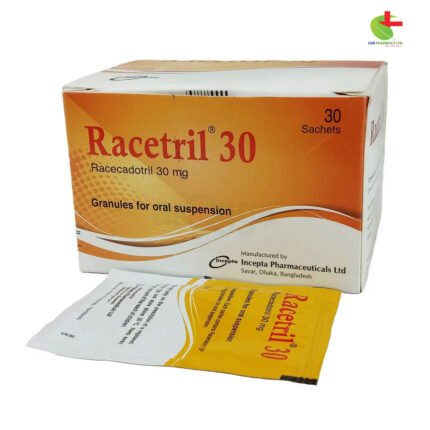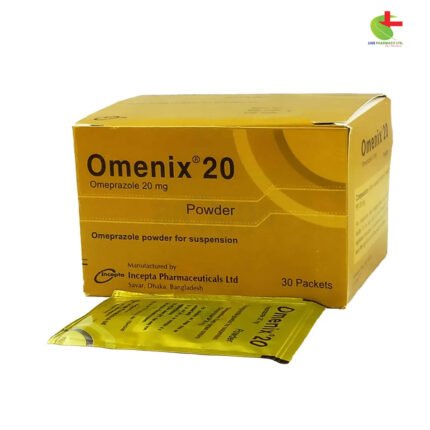Esonix 20
210.00৳ Pack(1*30)
- Esonix is a proton pump inhibitor indicated for the relief of chronic heartburn, healing and maintenance of erosive esophagitis, and the eradication of Helicobacter pylori in duodenal ulcer patients.
- It works by suppressing gastric acid secretion through specific inhibition of the H+/K+-ATPase in gastric parietal cells.
- Common side effects include headache, nausea, and diarrhea, while safety in pregnant or lactating women has not been well established.
- Esonix is contraindicated in patients with known hypersensitivity to its components and should be taken one hour before meals for optimal efficacy.
 Brand
Brand
|
Incepta Pharmaceuticals Ltd |
|---|---|
 Generics
Generics
|
Esomeprazole |
 Type
Type
|
Oral Powder |
Indications
Esonix is prescribed for the following conditions:
- Relief from chronic heartburn and symptoms related to gastroesophageal reflux disease (GERD)
- Healing of erosive esophagitis
- Maintenance of healing in erosive esophagitis
- Eradication of Helicobacter pylori infection in conjunction with amoxicillin and clarithromycin for patients suffering from duodenal ulcers
- Treatment of Zollinger-Ellison Syndrome
- Management of acid-related dyspepsia
- Treatment of duodenal and gastric ulcers
Always follow the advice of a registered healthcare professional when using this medication.
Pharmacology
Esomeprazole acts as a proton pump inhibitor, effectively reducing gastric acid secretion through selective inhibition of the H+/K+-ATPase in the gastric parietal cells. As the S-isomer of omeprazole, esomeprazole is the first single optical isomer in this class, offering superior acid control compared to racemic proton pump inhibitors.
Absorption: The enteric-coated pellet formulation of esomeprazole magnesium results in peak plasma concentrations occurring around 1.5 hours after oral administration. Increased dosages yield proportionately higher Cmax levels, with a notable increase in the area under the plasma concentration-time curve.
Dosage
Oral Dosage Forms:
- Healing of Erosive Esophagitis: 20 mg or 40 mg once daily for 4-8 weeks; most patients heal within this timeframe. For those who do not, an additional 4-8 weeks may be warranted.
- Maintenance of Healing: 20 mg once daily (studies did not extend beyond 6 months).
- Symptomatic GERD: 20 mg once daily for 4 weeks; if symptoms persist, an additional 4 weeks may be considered.
- Helicobacter Pylori Eradication: In a triple therapy regimen to prevent duodenal ulcer recurrence: 40 mg of esomeprazole once daily, along with 1000 mg amoxicillin twice daily and 500 mg clarithromycin twice daily for 10 days.
- Zollinger-Ellison Syndrome: Doses of 20-80 mg once daily, adjusted according to individual needs, and continued as clinically necessary.
- Acid-related Dyspepsia: 20-40 mg once daily for 2-4 weeks based on patient response.
- Duodenal Ulcer: 20 mg once daily for 2-4 weeks. Gastric Ulcer: 20-40 mg once daily for 4-8 weeks.
IV Injection or Infusion:
- GERD with Erosive Esophagitis in Adults (≥18 years): 20 mg or 40 mg once daily via IV injection (administered over >3 minutes) or IV infusion (over 10-30 minutes).
- Pediatric Patients (1-17 years):
- Weight <55 kg: 10 mg once daily
- Weight ≥55 kg: 20 mg once daily
- 1 month to <1 year: 0.5 mg/kg once daily
- IV Infusion: 10-30 minutes.
- Risk Reduction of Rebleeding from Gastric or Duodenal Ulcers: Adults (≥18 years): 80 mg via IV infusion over 30 minutes, followed by a continuous infusion of 8 mg/hour for a total of 72 hours.
Always follow the advice of a registered healthcare professional when using this medication.
Administration
Tablets/Capsules: Swallow whole, taking them one hour before meals.
Oral Suspension: Mix the contents of a packet with 15 ml of water in a small glass. Stir well, allow to thicken for 2-3 minutes, stir again, and consume within 30 minutes. If any remains, add more water, stir, and drink immediately. For nasogastric or gastric tube administration, use 15 ml of water, shake, allow to thicken, and inject into the stomach within 30 minutes.
IV Injection: Prepare the solution by adding 5 ml of 0.9% sodium chloride to the dry powder in the vial. The reconstituted solution should be clear and slightly yellow. Administer the IV injection over at least 3 minutes. Use within 12 hours of preparation and store below 30°C.
Always follow the advice of a registered healthcare professional when using this medication.
Interaction
Esonix undergoes extensive liver metabolism via CYP2C19 and CYP3A4. Studies indicate that Esonix does not significantly inhibit other CYP enzymes, suggesting minimal interactions with drugs metabolized by these pathways. No clinically relevant interactions have been identified with phenytoin, warfarin, quinidine, clarithromycin, or amoxicillin.
Caution is advised as Esonix may interfere with the metabolism of drugs reliant on CYP2C19, such as diazepam, which can increase plasma levels of diazepam when taken concurrently. As Esonix inhibits gastric acid secretion, it may affect the absorption of medications where gastric pH is crucial for bioavailability, such as ketoconazole and iron salts.
Co-administration with oral contraceptives and other medications has shown no significant alterations in Esonix’s pharmacokinetics.
Contraindications
Esomeprazole is contraindicated in patients with known hypersensitivity to any component of its formulation.
Side Effects
Common adverse effects associated with Esonix include headache, diarrhea, nausea, flatulence, abdominal pain, constipation, and dry mouth. No significant differences in adverse event types have been observed between short-term and long-term treatment.
Pregnancy & Lactation
While there are no well-controlled studies in pregnant women, animal studies have shown no teratogenic effects. The effects of esomeprazole on breast milk have not been studied; therefore, breastfeeding should be avoided if the use of esomeprazole is deemed necessary.
Precautions & Warnings
General: A symptomatic response does not rule out gastric malignancy.
Patient Information: Take Esonix capsules at least one hour before meals. For those who have difficulty swallowing, capsules can be opened, and the pellets mixed with a tablespoon of applesauce (not hot and soft enough to swallow). Do not chew or crush the pellets, and the mixture should not be stored for later use. Antacids may be taken concurrently with Esonix.
Use in Special Populations
Pediatric Use: Safety and efficacy in pediatric patients have not been established.
Geriatric Use: No significant differences in safety and efficacy have been noted between older and younger individuals; however, increased sensitivity cannot be ruled out.
Hepatic Insufficiency: No dosage adjustments are needed for mild to moderate hepatic impairment. For severe cases, a maximum dose of 20 mg once daily is recommended.
Renal Insufficiency: The pharmacokinetics of Esonix in renal impairment are not expected to differ from healthy individuals, as less than 1% is excreted unchanged in urine.
Overdose Effects
A lethal oral dose of 510 mg/kg (approximately 103 times the human dose) has been noted in rats. Symptoms of acute toxicity include reduced motor activity, respiratory changes, tremors, ataxia, and clonic convulsions. There have been no documented overdose cases with Esonix, and no specific antidote is available. Supportive and symptomatic treatment is recommended in case of overdose.
Storage Conditions
Store at temperatures not exceeding 30°C in a dry place, away from light and moisture. Keep out of reach of children.













Reviews
There are no reviews yet.